|
|
The Royal Naval Patrol Service at war |
| The Battle of Mesco Point ( 'Punta Mesco') - by Lieutenant Bryan Cambray, RNVR |
|
|
How often during World War II did armed trawlers, those maids of all work, depart from their normal role of escorting slow convoys of merchantmen, leading landing craft to their destinations, carrying out anti-submarine patrols and so on, and actually go out "looking for trouble"? I would imagine that few people indeed could recall a single occasion but, to those involved, the Battle of Mesco Point north of Spezia, Italy, in December 1944, ranked with many a more famous naval engagement. Moreover, it was highly successful.
A "big ship battle" in miniature was how it was described in the Lloyd's List and Shipping Gazette of January 26, 1945, five trawlers taking the parts of battleships while 16 British and American torpedo boats and gun boats acted as escorting destroyers.
The trawlers involved were HMS Minuet (Lt.-Cdr. Thornton Bate, RNVR) as flotilla leader with HMS Twostep (Lt. Jack Nye, RNVR), HMS Hompipe (Lt.-Cdr. de Legh, RNR), HMS Gulland(Lt. G.A. Anderson, RNVR) and HMS Ailsa Craig (Lt. T.G. Hornsby, RNR)
|
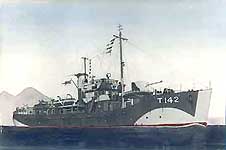 |
|
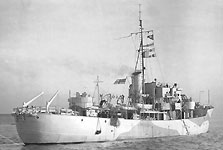 |
| HMS Twostep - a 'Dance Class' Admiralty built trawler |
|
|
| HMS Gulland - an 'Isles Class' Admiralty built trawler |
|
|
I was then a Sub-Lieutenant. RNVR. aboard Twostep. As with the Sub. in most small ships I had a multitude of duties, my prime role being that of navigation officer and, because I had been a Ldg. Telegraphist, signals officer. We left Leghorn before dusk and headed out almost due west, turning north after nightfall. The "destroyers" sailed much later, joining us shortly before we reached the area south-west of Mesco Point.
Intelligence had reported that the Germans were evacuating supplies to Genoa from Spezia by sea at night, heading up the coast away from the approaching land forces. Our job was to search and destroy.
We had not long to wait before the Senior Officer of the force reported that one of the Coastal Forces craft had sighted an enemy convoy heading north, well in-shore and under the lee of the cliffs. Immediately, the line of trawlers headed towards the coast and, at a range of about 2,000 yards, opened up with starshell, illuminating the target. The two Island class trawlers, with their 12-pounders, had the primary task of keeping the starshells going throughout the action, Ailsa Craig actually firing 87 rounds in nine minutes. Meanwhile the Dance class trawlers, with their heavier and somewhat archaic 4 in, guns, occupied themselves with the convoy itself. Actually HMS Gulland found herself so close to an R-boat that she changed roles and sank it with little effort.
  |
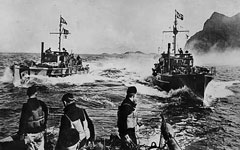 |
|
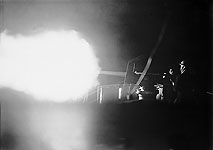 |
| German r-boat (or 'raeumboot') Flotilla |
|
|
| The 'heavy gun' bursts into the night |
|
Things really hotted-up then. The trawlers closed to about 800 yards, hammering away with their main armament and keeping up the pressure with their secondary guns -- in Twostep we had Oerlikon platforms just forward of the wheeihouse, port and starboard; two twin-Brownings at the rear of the bridge; and, at the stern, twin Vickers 0.5 in. machine guns.
Intelligence had reported that the area ashore was free from coastal or anti-aircraft batteries. How wrong they were! A few moments after our first starshell burst, the "non existent" coastal batteries opened up, adding their weight to the not inconsiderable fire put up by the German R-boats and merchantmen. Fortunately we were so close in-shore that the shells, which sounded like demoniac express trains, passed harmlessly overhead. The Germans could not depress their guns sufficiently to hit us. What size they were I don't know, but each shell sounded as though it would have demolished a trawler without much effort!
Within a few minutes of the Germans retaliating, our skipper, Jack Nye, a very large man in every way, was hit by a shell splinter, breaking his arm. Lt. John Hand, RNVR., promptly took command while a couple of ratings had the unenviable task of removing some 18 stone of officer from the bridge to his cabin where he could be given the necessary first aid. He consoled himself by taking copious swigs of whisky -- to dull the pain was his explanation!
By this time the Germans had opened up with what, to me as I took frequent and hurried glances out of the chart house, appeared to be a considerable amount of small arms fire -- it was almost fascinating to watch the criss-crossing of the various coloured tracers. Even more fascinating was the way tracer appeared to approach at a snail's pace until the last couple of hundred yards, only to disappear past me in a flash.
|
|
As we crawled along at three knots, ten minutes passed -- ten minutes which seemed like ten seconds to some, ten hours to others; then the order came "Trawlers clear the coast". I had never realised that Twostep could go so fast. Dropping smoke cannisters as we went, with the Coastal Forces also laying a smoke screen, we left Mesco Point very much more quickly than we had approached it! We had had various ideas about chaining depth charges set at 50 ft. to a couple of empty oil drums, each with a small hole in it so that long after we had departed the Germans would be aroused by the explosions, but we departed in too much haste for such fun and games.
As dawn broke we took toll of the damage. The sole casualty was our skipper and, apart from a few superficial holes in the superstructure, the trawlers were unscathed. I was somewhat perturbed to find several bullet holes a foot or so above my head level in the wooden chart house but there was little other damage. Actually when Jack Nye was hit our radio aerials were carried away but our two radio operators, Telegraphists Carter and West, jury-rigged an excellent substitute within a couple of minutes.
On the other side, out of three E- or R-boats and five merchantmen, one R-boat and three merchantmen were sunk and further merchantmen severely damaged; a successful night's work.
  |
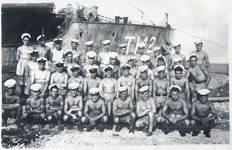 |
|
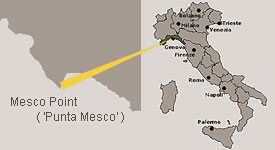 |
| HMS Twostep's crew Italy 1944 |
|
|
| Location of Mesco Point north of Spezia, Italy |
|
An amusing sidelight to all this was that a padre. Father W.E. Meyjes. had hitched a lift in HMS Ailsa Craig -- "The only man on my bridge who wasn't ducking with the rest of us was the Roman Catholic padre -- every time we bobbed down he bobbed up to take photographs", the captain reported later. One of the many duties of armed trawlers was that of anti-submarine patrols. When our flotilla was at Algiers in late 1943 we plied to and fro across the bay, a somewhat monotonous exercise.
For reasons I cannot remember -- officers sick probably -- I was seconded to another trawler in our flotilla for a couple of days. The first afternoon I was on watch, and we were heading east across the bay. Coming fast from seawards, on my port side, was a destroyer. Naturally 1 held my course and speed but it was obvious that the destroyer was not going to give way for a mere trawler, rules of the road or not. Eventually I had no option but to go full astern, hard a-starboard -- and the destroyer tore by with very little room to spare. Then, to my amazement the destroyer hoisted " Indicate name and rank of officer of the watch".
There was a tap on my shoulder and the venerable captain of the trawler, a Lt.-Cdr. RNR., murmured: "Leave it to me laddie". His reply was more than pointed: "Lt.-Cdr. X, RNR., extra master's certificate in sail, extra master's certificate in steam -- and I have never witnessed such diabolical seamanship in my life".
During the latter end of the war my armed trawler was returning to Naples after a few days in Malta. There was a strong southerly wind blowing and the night was extremely dark. As I approached the bridge to take over the morning watch I heard the following:
"Bridge" from the look-out.
"Yes?" from the officer of the watch, a new Sub.-Lt. RNVR.
"Land dead ahead, sir".
There was a short pause.
Sub.''That can't be land -- Capri is about 20 miles away. It must be low cloud".
Another short pause.
"Bridge"
"Yes?"
"It must be a ruddy low cloud, sir -- the sea is breaking on it". So much for deadreckoning -- it was Capri!
|
|
|
|
|